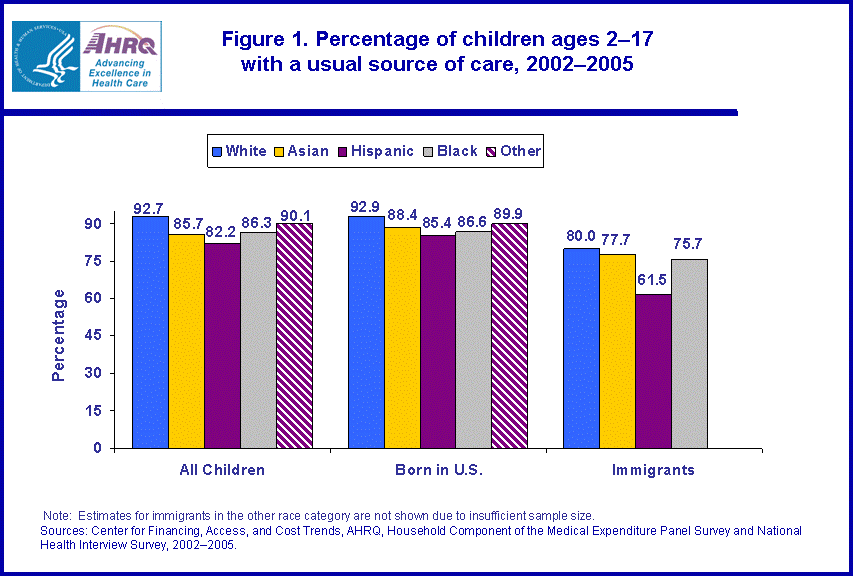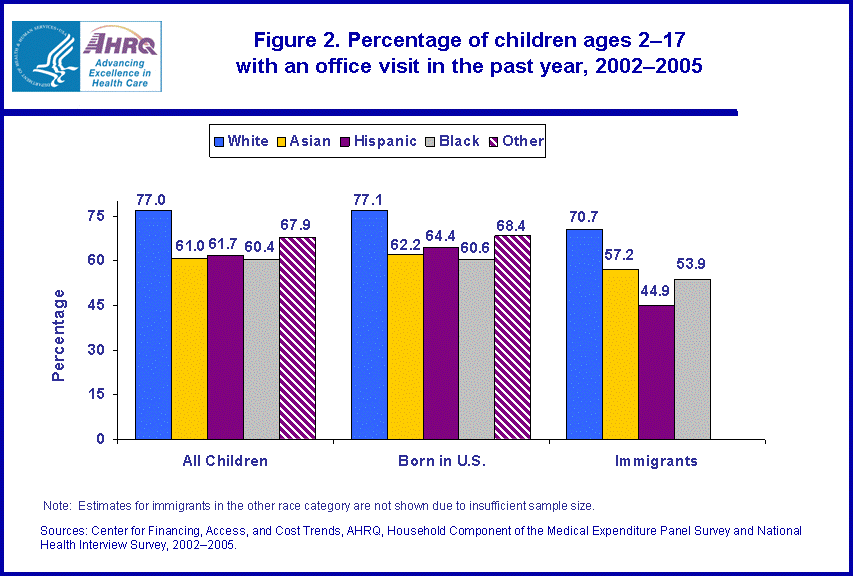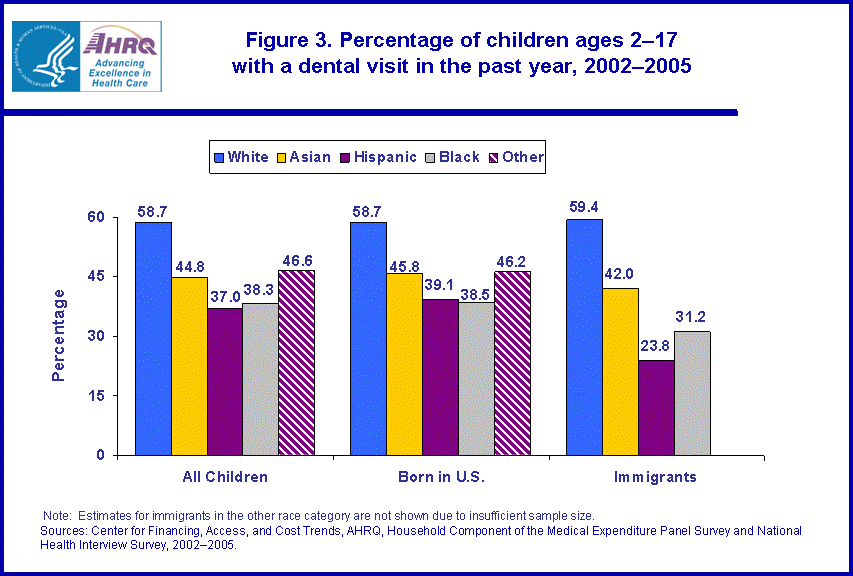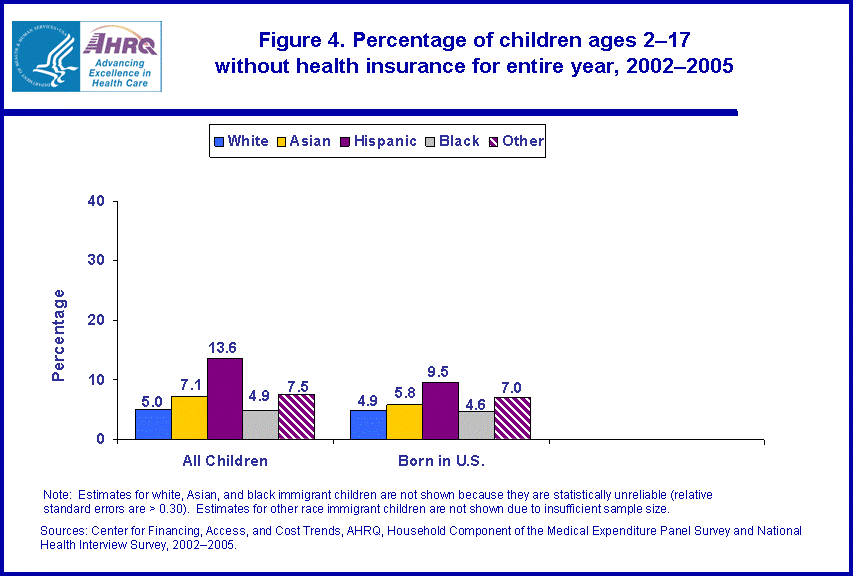
|
|
Font Size:
|
||||
|
|
|
|
||||
STATISTICAL BRIEF #224:
Differences in Access to Care for Non-Hispanic Asian and Non-Hispanic White Children, 2002-2005
Highlights
- For the period 2002 through 2005, Asian children ages 2 through 17 were less likely than white children to have a usual source of care, office visit, or dental visit. For instance, 85.7 percent of Asian children had a usual source of care, compared with 92.7 percent of white children.
- 61.0 percent of Asian children had one or more annual office visits, compared with 77.0 percent of white children--a difference of 16 percentage points.
- 44.8 percent of Asian children and 58.7 percent of white children had an annual dental visit--a difference of 13.9 percentage points.
- On average, 13.6 percent of all Hispanic children and 39.5 percent of Hispanic immigrant children did not have health insurance for an entire calendar year (data not shown).
- There are no statistically significant differences between Asian and white children in the percentage of children without health insurance coverage for an entire calendar year or for six or more months during a year.
Introduction
Non-Hispanic Asians are one of the fastest growing racial or ethnic groups in the United States, largely due to increases in immigration. In 2000, 62 percent of Asian and Pacific Islanders in the U.S. were immigrants.1 From 2004 through 2006, 77 percent of Asian adults were immigrants.2 Many of these immigrants face significant linguistic and cultural barriers which may affect their ability to access health care.
Children's access to health care is important in order to prevent potential health care problems and to treat acute and chronic conditions. The most rapid stages of a person's growth and change occur during childhood. Consequently, regularly monitoring children's height and weight, and assessing their psychosocial and behavioral development may help identify problems early and help control health care expenditures. Well-child visits to health care providers also give parents an opportunity to ask questions and make sure that their children have all recommended immunizations.
This Statistical Brief compares access to health care for three groups of non-Hispanic Asian and white children ages 2 through 17: 1) all children, 2) children born in the U.S., and 3) immigrants. For context, estimates of the access to care measures for Hispanic, black, and other race children are also presented, and some estimates for children in these additional racial/ethnic categories are discussed. The children in the 'Other' race category include Pacific Islanders, Native Americans, native Alaskans, native Hawaiians, and children of multiple races.
Five measures of access to care are presented. The measures estimate the average percentage of children in the past year who had: 1) a usual source of care, 2) one or more office visits, 3) one or more dental visits, 4) no health insurance coverage for an entire calendar year, and 5) no health insurance coverage for 6 to 12 months in the past year. Estimates in this brief are based on data from the Household Component of the Medical Expenditure Panel Survey (MEPS-HC) pooled for 2002 through 2005. All differences between estimates discussed in the text are statistically significant at the 0.05 level.
Findings
For the period 2002 through 2005, non-Hispanic Asian children were less likely than non-Hispanic white children to have a usual source of care (figure 1), office visit (figure 2), or dental visit (figure 3). Asian children born in the U.S. were also less likely than white children born in the U.S. to have a usual source of care, office visit, or dental visit. There were no statistically significant differences in these measures for Asian and white immigrant children. For the period 2002 through 2005, 1.9 percent of white children and 25.0 percent of Asian children were immigrants (not shown).
Figure 1 shows that Asian children were 7.0 percentage points less likely than white children to have a usual source of care (92.7 percent of white children versus 85.7 percent of Asian children). There was a 4.5 percentage point difference in this measure for Asian and white children born in the U.S.
There were larger differences in access to care as measured by whether children had an annual office or dental visit. As shown in figure 2, Asian children were 16 percentage points less likely than white children to have an office visit (77.0 percent of white children versus 61.0 percent of Asian children). Among children born in the U.S., Asian children were 14.9 percentage points less likely than white children to have an office visit (77.1 percent versus 62.2 percent). Among immigrant children, Hispanic children were 25.8 percentage points less likely than white children to have an office visit (70.7 percent of white immigrant children versus 44.9 percent of Hispanic immigrant children).3
Asian children were 13.9 percentage points less likely than white children to have an annual dental visit (58.7 percent of white children versus 44.8 percent of Asian children), as shown in Figure 3. Among children born in the U.S., Asian children were 12.9 percentage points less likely than white children to have a dental visit (58.7 percent versus 45.8 percent). Among immigrant children, Hispanic children were 35.6 percentage points less likely than white children to have a dental visit (59.4 percent versus 23.8 percent).4
For the period from 2002 through 2005, 7.1 percent of Asian children were uninsured, on average, for an entire calendar year, compared with 5.0 percent of white children (Figure 4). Among children born in the U.S., 5.8 percent of Asian children were uninsured, on average, compared with 4.9 percent of white children. However, there are no statistically significant differences between Asian and white children in the percentage of children without health insurance coverage for an entire calendar year. Thirty-nine and one-half percent of Hispanic immigrant children were uninsured, on average, for an entire calendar year (data not shown).
For 6 or more months during the year, on average, 8.2 percent of white children were uninsured, compared with 11.6 percent of Asian children and 20.4 percent of Hispanic children. Among children born in the U.S., 8.2 percent of white children were uninsured, on average, compared with 10.4 percent of Asian children and 16.1 percent of Hispanic children. There are no statistically significant differences between Asian and white children in the percentage of children without health insurance coverage, on average, for 6 or more months during the year.
Data Source
The estimates in this Statistical Brief are based on data from the MEPS-HC and National Health Interview Survey (NHIS) pooled for 2002 through 2005. The data are pooled to increase statistical precision.
Individual-level data on immigration status are from the NHIS. The NHIS, conducted by the National Center for Health Statistics, is a major source of information on the health of the civilian, institutionalized population of the U.S. Each year the MEPS household sample is drawn from the NHIS sampling frame.
Definitions/Methodology
Racial and ethnic classifications
Classification by race and ethnicity is mutually exclusive and based on information reported for each family member. Respondents were asked if each family member's race was best described as white, black, Asian, American Indian, Alaska Native, native Hawaiian, Pacific Islander, or multiple races. All persons whose main national origin or ancestry was reported as Hispanic, regardless of racial background, is classified as Hispanic. All non-Hispanic persons whose race was reported as American Indian, Alaska native, native Hawaiian, or multiple races are classified in the other race category.
Age
Age is the last available age for the sampled person. For most persons, this was their age at the end of the year.
Children
Children are ages 2 through 17 and eligible for the Access to Care section of MEPS-HC. Some other MEPS Statistical Briefs use different age ranges for children. The Access to Care section of the MEPS-HC holds information on family members' usual source of health care, satisfaction with and access to the usual source of health care provider, and access to medical treatment, dental treatment, and prescription medicines.
Usual source of care
An individual has a usual source of care if there is a particular doctor's office, clinic, health center, or other place (excluding hospital emergency rooms) that the individual usually goes to if he or she is sick or needs advice about his/her health.
Office Visits in Past Year
Office visits in the past year include office visits to physician and nonphysician providers. Nonphysician providers include chiropractors, midwives, nurses, nurse practitioners, optometrists, podiatrists, physician's assistants, physical therapists, occupational therapists, psychologists, social workers, technicians, receptionists/clerks/secretaries, or other medical providers.
Health Insurance
Children are defined as insured during a month if they held one of the following types of coverage any time during that month: private insurance, Medicaid, Medicare, TRICARE, SCHIP (State Children's Health Insurance Program), or other public hospital/physician coverage. Children without health insurance for part of the year (6 to 12 months or 3 to 12 months) could have nonconsecutive months without insurance coverage. Estimates of immigrant children without health insurance for an entire calendar year in the white, Asian, black, and other race categories are not presented because they are considered unreliable due to relative standard errors larger than 0.30.
About MEPS-HC
MEPS-HC is a nationally representative longitudinal survey that collects detailed information on health care utilization and expenditures, health insurance, and health status, as well as a wide variety of social, demographic, and economic characteristics for the civilian, noninstitutionalized population. It is cosponsored by the Agency for Healthcare Research and Quality and the National Center for Health Statistics.
For more information about MEPS, call the MEPS information coordinator at AHRQ (301-427-1656) or visit the MEPS website at http://www.meps.ahrq.gov/.
References
For information on the demographic and health characteristics of Asians, see the following publications:
Barnes, P., P. Adams, and E. Powell-Griner. Health Characteristics of the Asian Adult Population: United States, 2004-2006. Advance data from vital and health statistics, no. 394. Hyattsville, MD: National Center for Health Statistics, 2008.
Schmidley, A.D. Profile of the Foreign-Born Population in the United States: 2000. U.S. Census Bureau, Current Population Reports, Series P23-206. U.S. Government Printing Office, Washington, DC, 2001.
For a description and discussion of recommendations for preventive pediatric health care, see the following publication:
Committee on Practice and Ambulatory Medicine and Bright Futures Steering Committee. Recommendations for Preventive Pediatric Health Care. Pediatrics, December 2007: 120(6): 1376.
For a detailed description of the MEPS-HC survey design, sample design, and methods used to minimize sources of nonsampling error, see the following publications:
Cohen, J. Design and Methods of the Medical Expenditure Panel Survey Household Component. MEPS Methodology Report No. 1. AHCPR Pub. No. 97-0026. Rockville, MD: Agency for Health Care Policy and Research, 1997. http://www.meps.ahrq.gov/mepsweb/data_files/publications/mr1/mr1.shtml
Cohen, S. Sample Design of the 1996 Medical Expenditure Panel Survey Household Component. MEPS Methodology Report No. 2. AHCPR Pub. No. 97-0027. Rockville, MD: Agency for Health Care Policy and Research, 1997. http://www.meps.ahrq.gov/mepsweb/data_files/publications/mr2/mr2.shtml
Cohen, S. Design strategies and innovations in the Medical Expenditure Panel Survey. Medical Care, July 2003: 41(7) Supplement: III-5-III-12.
Suggested Citation
Sing, M. Differences in Access to Care for Non-Hispanic Asian and Non-Hispanic White Children, 2002-2005. Statistical Brief #224. October 2008. Agency for Healthcare Research and Quality, Rockville, MD, http://www.meps.ahrq.gov/mepsweb/data_files/publications/st224/stat224.shtml
AHRQ welcomes questions and comments from readers of this publication who are interested in obtaining more information about access, cost, use, financing, and quality of health care in the United States. We also invite you to tell us how you are using this Statistical Brief and other MEPS data and tools and to share suggestions on how MEPS products might be enhanced to further meet your needs. Please e-mail us at mepspd@ahrq.gov or send a letter to the address below:
Steven B. Cohen, PhD, Director
Center for Financing, Access, and Cost Trends
Agency for Healthcare Research and Quality
540 Gaither Road
Rockville, MD 20850
1Schmidley, A.D. Profile of the Foreign-Born Population in the United States: 2000. U.S. Census Bureau, Current Population Reports, Series P23-206. U.S. Government Printing Office, Washington, DC, 2001.
2Barnes, P., P. Adams, and E. Powell-Griner. Health Characteristics of the Asian Adult Population: United States, 2004-2006. Advance data from vital and health statistics, no. 394. Hyattsville, MD: National Center for Health Statistics, 2008.
3There are no statistically significant differences in the percentage of white and Asian immigrant children who had an office visit in the past year.
4There are no statistically significant differences in the percentage of white and Asian immigrant children who had a dental visit in the past year.
 |
||||||||||||||||||||||||||||||||
|
||||||||||||||||||||||||||||||||
|
|
||||||||||||||||||||||||||||||||
 |
||||||||||||||||||||||||||||||||
|
||||||||||||||||||||||||||||||||
|
|
||||||||||||||||||||||||||||||||
 |
||||||||||||||||||||||||||||||||
|
||||||||||||||||||||||||||||||||
|
|
||||||||||||||||||||||||||||||||
 |
||||||||||||||||||||||||||||||||
|
||||||||||||||||||||||||||||||||
|
|
||||||||||||||||||||||||||||||||
 |
||||||||||||||||||||||||||||||||
|
||||||||||||||||||||||||||||||||
|
|
||||||||||||||||||||||||||||||||


